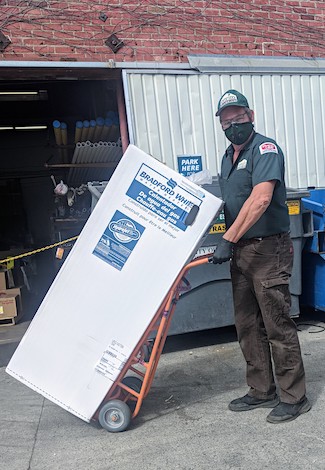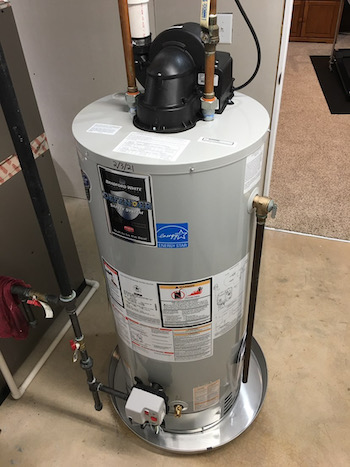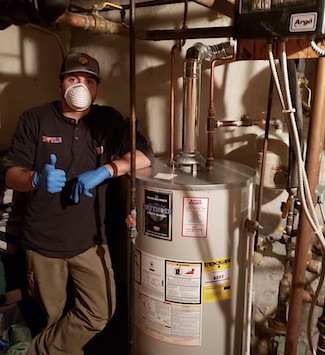What lessons did the Bradford White team learn in 2020? In a year dominated by COVID, COVID, COVID, we learned the value of flexibility and communication above all else.
 Early in the pandemic we were able to successfully assert that we—as a company, in our factories, our distributors and our contractors—are essential to the health of the country. We can’t do without hot water for sanitation, cooking, cleaning, and bathing in hospitals, nursing homes, military installations, food processing plants and in America’s homes. Our contractor customers are vital and essential providers of heat and hot water. There was much that we didn’t know back then, and supply chains began to shut down. Adding to the confusion, the U.S.-based supply chain was operating under different COVID rules and restrictions than what we saw with non-U.S. suppliers. We worked through the initial uncertainty about how we could best protect our employees and stabilized our factories in Middleville and Niles, Michigan, and Rochester, N.H.
Early in the pandemic we were able to successfully assert that we—as a company, in our factories, our distributors and our contractors—are essential to the health of the country. We can’t do without hot water for sanitation, cooking, cleaning, and bathing in hospitals, nursing homes, military installations, food processing plants and in America’s homes. Our contractor customers are vital and essential providers of heat and hot water. There was much that we didn’t know back then, and supply chains began to shut down. Adding to the confusion, the U.S.-based supply chain was operating under different COVID rules and restrictions than what we saw with non-U.S. suppliers. We worked through the initial uncertainty about how we could best protect our employees and stabilized our factories in Middleville and Niles, Michigan, and Rochester, N.H.
We’re entering a new phase of COVID-19 these days, with an evolving sense of normalization. We’re still currently running our plants to maximize employee safety, and we’re doing so in a market where there is high demand for our products.

Photo Credit: Alan Carlson, Armbrust Plumbing & Heating
We follow state and national requirements for PPE. We run through health protocols daily with a questionnaire and a temperature check for all employees, and we’ve adjusted our scheduling to handle that. We exercise social distancing where possible and employ contact tracing measures when necessary. We clean and sanitize our factories frequently. It’s been gratifying to hear feedback from those business partners who are authorized to come into the factory that we are going above and beyond to keep employees safe compared to what they’ve seen elsewhere. I feel very good about what we’re doing to look out for the health of our employees while striving to meet our customer commitments.
You can’t communicate enough. Constant communication with our customers is crucial. We understand our distributors’ day-to-day demands and frequently communicate with them through our sales team and rep network. All their manufacturers have been affected and in different ways, so distributors have a lot of questions. We share information with contractors through our For the Pro® site, and the contractors we talk with have all been busy.
 The same goes for our employees. Communicate and then communicate some more. It’s imperative to share reliable (and factual) information with our employees to avoid confusion. If people can’t get reliable information, they may fill in the blanks and fuel an already overflowing COVID rumor mill. We had about 150 employee communications last year and 80% of them were associated with the pandemic. You have to make sure your employees understand what it takes to be safe both in and out of the workplace. The coronavirus has been particularly difficult because information on the disease and availability of vaccines varies from state to state and even county to county.
The same goes for our employees. Communicate and then communicate some more. It’s imperative to share reliable (and factual) information with our employees to avoid confusion. If people can’t get reliable information, they may fill in the blanks and fuel an already overflowing COVID rumor mill. We had about 150 employee communications last year and 80% of them were associated with the pandemic. You have to make sure your employees understand what it takes to be safe both in and out of the workplace. The coronavirus has been particularly difficult because information on the disease and availability of vaccines varies from state to state and even county to county.
Where’s the best guidance coming from? It’s difficult to say what’s the best source, but the CDC appears to have been the most consistent central source for national guidance on what to do for health and safety during the pandemic. Local information can vary by county or parish or municipality. In southwestern Michigan and southeastern Pennsylvania for example, where two of our facilities are located, the guidance varies from county to county, so one county may be on the second phase of shots while another county is barely in phase one. Our Canadian-based team must look to the Canadian government for guidance nationally and then understand what each of the provinces are saying.

How many of these practices will live on beyond the COVID-19 era? As far as products, we’ll continue to see increasing levels of connectivity and remote diagnostics, particularly on the commercial side of things where building management systems are commonplace for monitoring performance. This is not new, but the constraints of COVID have caused an acceleration in the development of more remote capabilities. Virtual learning will continue, but we believe that “hands-on” training experiences will continue to be preferred. In terms of our general industry dynamics, a lot of us are anxious to reduce our time in the virtual/remote world. For us, this is a relationship industry and we like to see our customers and suppliers face to face. We’re most effective when we can be with a contractor in their own space to understand their challenges. You need to ride shotgun in the truck so you can see what they see and hear what they see and hear. And a virtual trade show is not a substitute for the discoveries you can make seeing and touching new products. For a company like Bradford White that prides itself on its face-to-face customer relationships, this has been painful.
This pandemic has altered almost everything in our lives, including food, water, healthcare supply, healthcare delivery, supply chains, insurance plans and contracts. As we prepare for the next pandemic, the planning must include economic recovery along with the health aspect. We were looking at the bullseye, but we missed many of the rings around it. Now we can see how big of an impact COVID-19 has on all facets of our lives.
When it comes to doing business during a pandemic, you can’t deny the human element. When you talk about somebody’s health and well-being, including any challenges they’re experiencing regarding their financial health and well-being, it becomes emotional. As much as you might want to employ common sense and logic when it comes to work, people have lost loved ones and lost jobs. Plus, the coronavirus has become part of the partisan political landscape when we need to be bipartisan when it comes to taking care of the health of the country.
 Carl Pinto, Jr. is senior director of marketing communications for Bradford White.
Carl Pinto, Jr. is senior director of marketing communications for Bradford White.



